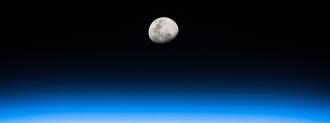This article is an installment of The Future Explored, a weekly guide to world-changing technology. You can get stories like this one straight to your inbox every Thursday morning by subscribing here.
NASA is in the market for moon rocks and lunar dirt — and any private company that can deliver the goods will receive up to $25,000 in compensation.
Why it Matters
$25k is pretty measly when you consider that you have to actually get to the moon and back in order to claim it — so, companies aren’t going to be in this for the money. Instead, this is more of an incentive for companies already planning a trip to the moon to try their hand at collecting and storing lunar material, something no private company has ever done.
The hope is that this will spur the development of new technologies that could be used to extract resources from the moon. NASA is also looking to normalize the concept of buying lunar resources from the private sector.
Clive Neal, a University of Notre Dame planetary scientist, told The Washington Post that this program is a “paradigm shift” that would allow “more sample returns from the moon” and “open up lunar resources.”
The most valuable lunar resource might be water. Scientists think that one day we could mine the moon for water and then convert that water into rocket fuel.
How to Transform Moon Water
If you split water into hydrogen and oxygen and then liquefy those atoms, voilà: you’ve got rocket fuel!
Space travel is expensive, and the high price tag is mostly because astronauts have to lift all of the fuel they need for the trip out of the Earth’s gravity well (and that’s a lot of fuel!). This makes the rocket much heavier, thus requiring even more fuel to lift, and therefore costlier to launch.
The ability to refuel in space would mean a cheaper travel budget, so we could potentially go further into space —like to Mars! — more often.
The Great Unknowns
There are lots of things we just don’t know yet. For one thing, there’s the logistical issue of even accessing the water — which is in the form of ice — because it’s located in dark, cold craters at the moon’s poles. Solar power is the main source of energy in space, so we may need nuclear power to run the mining and processing equipment (since bringing up chemical fuels from Earth is what we’re trying to avoid.)
If we do reach the ice, in order to make the moon a viable gas station, heavy machinery would have to stay at the poles. Although we know that rovers can last on the moon for a long period of time, we’re not sure that larger machinery can similarly withstand the cold temperatures and radiation. That means we also don’t know how much of the process we can automate — and having a large human crew do the work isn’t ideal, either, as it could be dangerous.
Still, Phil Metzger, a space technologist at the University of Central Florida, told MIT Tech Review‘s Neel Patel that the biggest technical hurdle and the only issue that “keeps us up at night” is the purification process. Unlike Earth’s ice caps, which are massive sheets of pure water, lunar ice is in the form of tiny grains mixed with surface material, so it’s really impure. It’s hard to develop a filtration process for contaminants specific to the moon — and these impurities could not only make the fuel unusable but also explosive.
Other Moon Treasures
The moon (and space rock in general) has a stockpile of valuable resources. It has rare Earth metals that are used in modern technology. There’s also Helium-3, which is a rare element that could be used to power future nuclear fusion reactors.
Wild, Wild, West
While no country can “own the moon” or any other celestial body, space law currently operates like maritime law: finders, keepers. And the race is on to find and extract lunar resources. In addition to the U.S., the European Space Agency wants to build a moon village. And China’s getting in on the action.
However, NASA wants to set the standards for the new wild-wild-West. In May, it revealed a legal framework for how countries and companies should operate on the moon. This framework (known as the Artemis Accords) encourages transparency when it comes to mining operations — for example, by creating “safety zones” around sites where mining and exploration would take place.
Onward
The next human mission to the moon (which NASA says will be in 2024, though some have doubts) will likely be an on-the-ground experiment when it comes to testing technologies that could allow astronauts to “live off the land.”
Metzger tells MIT Tech Review, “I don’t think the technologies that people are designing and conceiving of today are going to just work perfectly on the moon…but I do believe there will be a lot of industrial activity on the moon within several decades.”
We’d love to hear from you! If you have a comment about this article or if you have a tip for a future Freethink story, please email us at [email protected].






